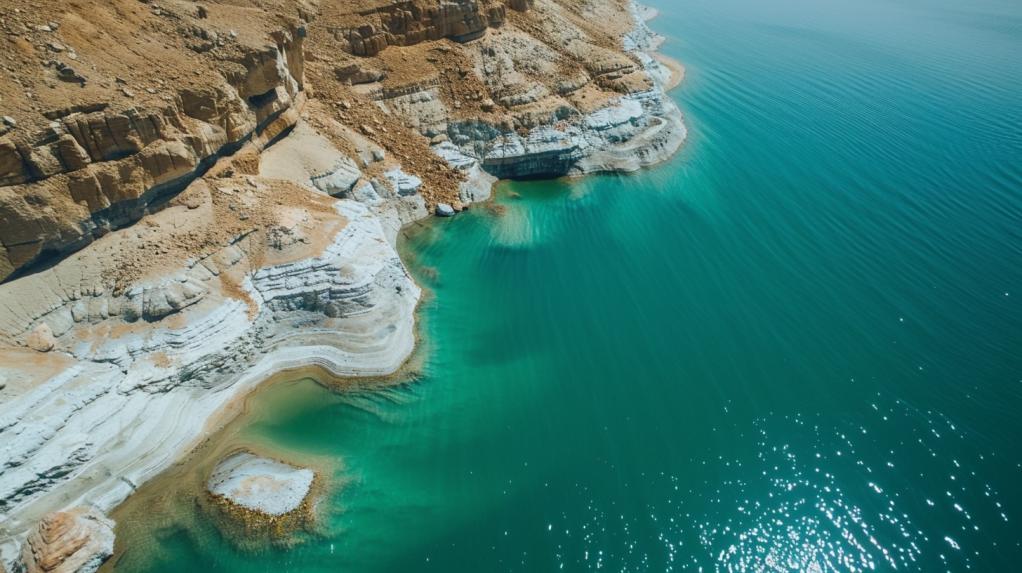The History and Geography of the Dead Sea

No matter who you are or where you come from, I’m sure you’ve heard of the Dead Sea. Routed in religion, housed in a strong geographical location and known for its magical mineral composition and therapeutic benefits, it’s one of the best-known natural wonders Earth has to offer. With so much history where do we begin? I think it’s best to start with its formation.
Formation of the Dead Sea
The Dead Sea's formation is a result of millions of years of geological evolution, initiated by the movement of the Arabian Plate away from the African Plate, creating the Jordan Rift Valley within the vast expanse of the Great Rift Valley. This tectonic activity formed a deep basin, which was gradually filled with water, predominantly from the Jordan River. Situated in a desert region, the basin experienced intense evaporation, leading to the concentration of minerals and salts, notably magnesium, potassium, and calcium chlorides, making the Dead Sea one of the planet's saltiest bodies of water. Over time, reduced inflow from the Jordan River, due to human diversion and natural climatic variations, alongside continuous evaporation, has contributed to the current state of the Dead Sea, characterized by its high salinity and shrinking water levels. This unique natural wonder is the outcome of a complex interplay between Earth's tectonic forces, climatic conditions, and human interventions.
The Dead Sea’s Geographical Location
Geologically, the Dead Sea is remarkable for being the lowest point on Earth's surface, at over 430 meters below sea level. The Dead Sea's geographical setting is remarkable. It lies in the Jordan Rift Valley and is bordered by Jordan to the east and Israel and the West Bank to the west. Its coastlines stretch approximately 50 kilometres long and are a spectacle of natural mineral deposits and rugged landscapes.
Religious significance of the Dead Sea
The Dead Sea is notably mentioned in the Christian Bible and the Hebrew Torah. It is mentioned in the Bible with different names such as the Salt Sea, the Sea of the Arabah, and the Eastern Sea. The regions around the Dead Sea are noted for their biblical associations with the stories of Sodom and Gomorrah, the wilderness where David sought refuge, and the area where John the Baptist conducted baptisms.
Sodom and Gomorrah
One of the most well-known biblical associations with the Dead Sea region is the story of Sodom and Gomorrah (Genesis 18-19). These cities, often linked to the southern area of the Dead Sea, were destroyed by fire and brimstone due to their inhabitants' wickedness. The story highlights themes of judgment and divine retribution but also mercy, as seen in the rescue of Lot and his family.
Refuge for David
The Dead Sea region, particularly the area of Ein Gedi, provided refuge for David during his flight from King Saul (1 Samuel 23:29-24:1). The caves and rugged terrain offered a strategic hiding place, leading to the famous incident in the cave where David spared Saul’s life.
The Prophet Ezekiel’s Vision
Ezekiel’s vision of the waters issuing from the Temple (Ezekiel 47:1-12) includes a transformation of the Dead Sea’s waters, bringing life where there was none. This prophecy symbolizes healing and restoration, suggesting a future where even the most desolate places are renewed.
Dead Sea Scrolls
Discovered between 1947 and 1956, the Dead Sea Scrolls provide insights into Second Temple Judaism, impacting our understanding of Jewish history and biblical studies.
Now that we’ve covered the religious implications, let’s discuss how the Dead Sea has evolved over the years.
Evolution of the Dead Sea
The Dead Sea has undergone significant transformations due to a combination of geological activities, climatic variations, and human interventions. Its origins trace back millions of years to tectonic movements within the Great Rift Valley, with the Jordan River serving as its primary water source. Over millennia, the Dead Sea's size and water levels have fluctuated dramatically, influenced by changing rainfall patterns and evaporation rates. In recent times, human activities, particularly the diversion of water from the Jordan River for agricultural and domestic purposes, have markedly reduced its inflow, leading to a rapid annual decline in water levels of over one meter. This shrinkage has precipitated environmental concerns, including the emergence of sinkholes, posing risks to both local ecosystems and infrastructure. Amid these challenges, conservation efforts, such as the proposed Red Sea–Dead Sea Water Conveyance project, aim to replenish the Dead Sea's water levels, although their potential impact remains a subject of debate. This narrative underscores the complex interplay between natural processes and human actions in shaping the Dead Sea's evolution, highlighting the critical need for sustainable management to preserve this unique natural wonder.
In conclusion, the history of the Dead Sea is a captivating narrative woven from the threads of geological marvels, climatic transformations, and human history. From its formation millions of years ago due to tectonic shifts that created the Jordan Rift Valley, to becoming one of the world's saltiest bodies of water through processes of intense evaporation in a desert climate, the Dead Sea tells a story of natural wonder and change.
Its shores have witnessed the rise and fall of civilizations, served as a site for ancient health and beauty practices, and inspired countless myths and historical accounts. Today, the Dead Sea stands as a testament to the dynamic processes that shape our planet, reflecting both the resilience and vulnerability of natural wonders in the face of environmental and human pressures. As we look to the future, the Dead Sea's ongoing challenges with shrinking water levels and ecological changes serve as a critical reminder of the importance of sustainable management of our planet's precious resources. The history of the Dead Sea is not just a tale of the past; it's a continuous story that urges us to act thoughtfully and preserve the legacy of this extraordinary natural phenomenon for generations to come.



